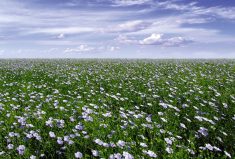It’s clear from where the Prairies’ cereal growers’ groups sit that it’s time for farmers to get more involved in wheat and barley breeding — and they have a new report in hand suggesting ways to do so.
Options in the report, from the newly-formed Wheat and Barley Variety Working Group, range from improving the way information is shared, to creating a new producer group to co-ordinate research — or even starting a new producer-owned cereal breeding company.
“Farmers’ interest is in seeing wheat and barley remain competitive in rotations over the long term,” says Garth Patterson, executive director of the Western Grains Research Foundation (WGRF), the agency that co-ordinated the new study.
Read Also

Brazil to reap record soy crop in 2025/2026, increase exports
Brazil’s Conab said the country will reap a record soybean crop of 177.6 million tons in the 2025/2026 harvest year, according to data released on Thursday.
Variety development research is needed, to make sure new cereal varieties with higher yields and disease resistance continue to be available.
The challenge is that wheat and barley are self-pollinating crops, less attractive to private-sector breeders than crops such as canola. Because farmers can save wheat and barley seed from year to year with minimal yield losses, they don’t need to pay for certified seed annually, and private-sector breeders find it difficult to recoup investments.
Neither the report’s authors nor the commissions involved recommend one particular option — just that farmers read the report, think about the issues and discuss the possibilities over the winter at producer meetings and commission AGMs.
Why now?
The commissions involved started discussing the need for this work about a year ago, Patterson says. “The driver here has been the changes to the wheat and barley checkoff.”
With the removal of the Canadian Wheat Board, new wheat and barely commissions and associations have been created across the Prairie provinces, funded through farmer levies on the sale of wheat and barley.
Until July 31, 2017, farmers also pay levies to the WGRF (56 cents per tonne of barley and 48 cents per tonne of wheat — except in Alberta, where farmers pay four cents per tonne of wheat to the WGRF, and $1 per tonne to their provincial wheat commission).
After July 31, 2017, it’s not clear if the WGRF levy will be discontinued or transferred to provincial commissions, or if another option will be found. For now, research will continue using the WGRF’s financial reserves. “We’re just finalizing five-year agreements to the end of 2019,” Patterson says.
Other regulatory changes have also led to the need for this study. There have been changes to the federal Plants Breeders Rights Act, designed to encourage increased investment. There is a possibility that end point royalties (EPR) — a system in which farmers would pay a variety royalty fee when they deliver their production — may be implemented in the future.
The study outlines two strategic choices farmers need to make. This first is “how should farmers be involved in varietal development?” Should farmers own assets? How much research should farmers fund through levies?
The second strategic question is “Should farmers support an EPR system?” Under such a system, farmers would pay royalties for the use of seed when they sold their production. This would increase farmers’ costs, but also provide more funding for cereal breeding.
The study
The study, “Exploring Options for Producer Involvement in Wheat and Barley Variety Development” was prepared by Ontario-based JRG Consulting Group.
The Wheat and Barley Variety Working Group, which commissioned the study, includes representatives from Alberta Barley, Alberta Wheat, the B.C. Grain Producers Association, Manitoba Wheat and Barley Association, SaskBarley Development Commission, SaskWheat Development Commission, Saskatchewan Winter Cereals Development Commission, WGRF and Winter Cereals Manitoba.
This leads to the need for a lot of logos on the final report. Patterson says the organizations are “very committed to working together and looking at this with a western Canadian approach.”
Patterson compares investing in variety research to investing for your retirement. It can take years for a new variety to come to the market — but new high-yielding varieties can make a big impact to farm economics.
“The little things you do now can have a big impact,” he says. “We don’t want to be 20 years down the road and say ‘This is how farmers might have positioned themselves in supporting wheat and barley breeding.'”
— Leeann Minogue is the editor of Grainews based at Griffin, Sask. Follow her at @GrainMuse on Twitter.













